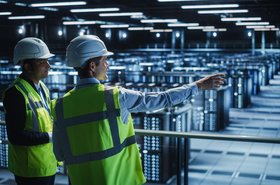The rapid rise of AI is reshaping industries worldwide, and the data center sector is no exception. Ahead of his talk at DCD Madrid 2025, Pieter Schaap, who has strong expertise in data center development provides invaluable insights into the opportunities and challenges that AI presents.
Spain: A key growth market
Spain is experiencing unprecedented growth, with an estimated 20 percent expansion in the first six months of 2024. This rapid acceleration is largely due to Spain being designated as an AI growth zone by the European Commission – this designation has attracted significant investment from both private developers and hyperscale operators, creating an ecosystem backed with national and international government support.
In 2024 alone, we’ve already seen over a billion euros invested into Spain’s data center infrastructure. Madrid remains a traditional hub, but we’re also seeing substantial activity in Zaragoza, Barcelona, Valencia, Extremadura, and Cantabria.
Spain’s appeal extends beyond its borders, thanks to its strong connectivity with North Africa, positioning it as a strategic location for international operators. Leading global data center players – including Atlas Edge, CyrusOne, Digital Realty, EdgeConneX, Equinix, Global Switch, Iron Mountain, and NTT, either already have or are actively developing facilities in Spain.
AI’s role in data center design and construction
The demand for AI-driven workloads is pushing the boundaries of traditional data center design and construction. Our industry is operating in the AI field as an accelerator and a future super-user. We are building the digital infrastructure that will be associated with one of the biggest changes in our daily lives within decades.
By building this infrastructure, we are able to transform the construction industry over time, whereby AI is playing a crucial role in streamlining processes by enhancing predictive analytics, optimizing resource allocation, and enabling real-time decision making.
Over time, AI will allow us to build smarter, not just faster. It helps us analyze vast amounts of data to optimise cooling systems, power distribution and even space utilisation. AI-powered design tools can create more efficient layouts, reducing wasted space while maximising energy efficiency. But for the immediate future, in data center development, we have to make do with the tools and systems that we have.
Boosting efficiency via AI-driven automation
One of the most exciting advancements is AI’s ability to automate and enhance traditional construction processes. AI-driven robotics and generative design software are improving project timelines and reducing errors.
For example, AI-powered BIM systems can identify potential clashes in design before construction begins, reducing costly rework. Additionally, automated drones and robots can monitor site progress in real time, ensuring that projects stay on track.
Sustainability and AI
Sustainability is a pressing concern in data center construction, and AI is proving to be a game-changer in reducing environmental impact. AI algorithms can analyze energy consumption patterns and recommend adjustments to cooling and power systems to improve efficiency.
By integrating AI-driven cooling optimization, we’ve seen significant reductions in energy usage. Machine learning models can predict when and where cooling is needed most, dynamically adjusting airflow to cut down on unnecessary power consumption.
Spain, while not a favourable climate for cooling, has strong sustainable power options such as wind and solar, particularly in regions like Zaragoza. The region is becoming an attractive location for large-scale data center developments, including a recently announced 300MW facility under Tillion Data Centers.
AI is facilitating the use of alternative materials and modular construction techniques, reducing waste and the overall carbon footprint of new facilities.
Key challenges and barriers to AI adoption
Despite AI’s advantages, its integration into data center construction isn’t without challenges. One of the primary concerns is the sector’s hesitation to embrace change – there’s a learning curve. Traditional construction methods have been around for decades, and shifting to AI-driven processes requires investment in training and technology.
Moreover, AI adoption demands significant data inputs and advanced analytics capabilities, which not all companies are equipped to handle. Data privacy and security also remain key concerns when using AI-powered monitoring and automation tools.
A look to the future
Looking ahead, there is optimism about the potential of AI to revolutionize data center design and construction. With greater collaboration between AI developers and construction firms, leading to more intuitive design tools and smarter building techniques.
In the next five to ten years, AI will be at the core of every major data center project. From AI-driven self-healing infrastructure to fully autonomous construction sites, the future is incredibly exciting.
The European Commission’s designation of Spain as one of the AI growth zones is incredibly significant, as it ensures international legislation and government policies will be favourable for continued data center expansion.
These decisions, made in consultation with industry stakeholders, signal strong demand from major operators looking to establish or expand their footprint in Spain. For companies looking to embrace AI, I advise starting small – implementing AI in specific areas such as predictive maintenance or energy optimization before scaling up to more complex applications.
As AI continues to shape the data center landscape, staying ahead of these innovations will be critical for companies aiming to remain competitive. Spain’s rapid growth, driven by AI advancements and international investment, exemplifies the transformative potential of AI in the industry. AI is not just a tool but a transformative force, driving efficiency, sustainability and scalability in the digital era.
For those eager to learn more, don’t miss Pieter Schaap’s session at DCD Madrid 2025 Monday 20th May, 3pm, on the main stage.
More from Soben

Sponsored
Cool climate, hot opportunity: Scotland’s data center promise
Demand for data centers in Europe is set to more than triple between now and 2030. As FLAPD markets near capacity, it’s time for new players to enter the market.

Sponsored
Move over FLAPD: Uncover the next wave of data center hotspots
As FLAPD markets near capacity, Soben’s Director shares views on how new markets are poised to reshape the future of data centers before debating the topic at DCD Connect London

Accenture buys Soben to boost data center construction offering
Undisclosed fee paid for consultancy that works with hyperscalers and colo providers
Read the orginal article: https://www.datacenterdynamics.com/en/opinions/design-and-construction-innovation-in-the-ai-era/



